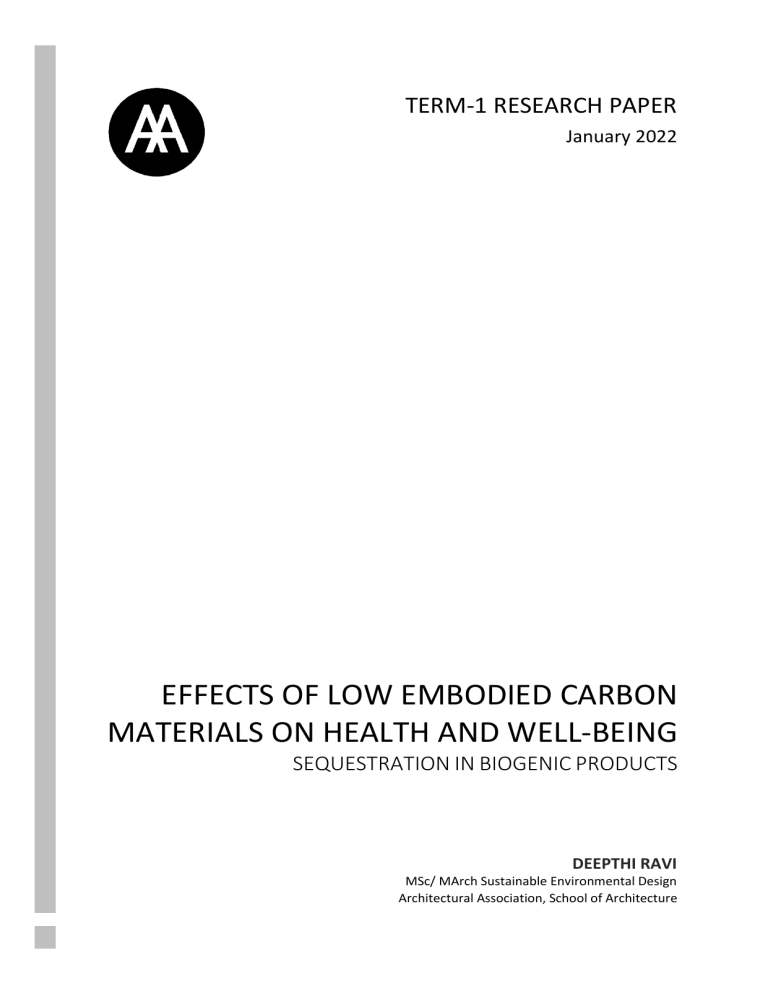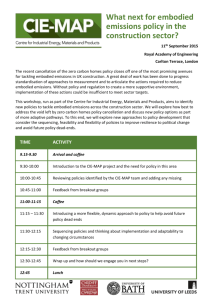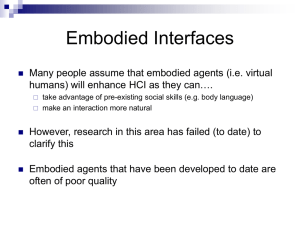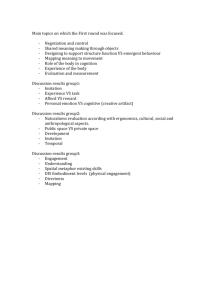
TERM-1 RESEARCH PAPER January 2022 EFFECTS OF LOW EMBODIED CARBON MATERIALS ON HEALTH AND WELL-BEING SEQUESTRATION IN BIOGENIC PRODUCTS DEEPTHI RAVI MSc/ MArch Sustainable Environmental Design Architectural Association, School of Architecture Authorship Declaration Form AA SED ARCHITECTURAL ASSOCIATION SCHOOL OF ARCHITECTURE PROGRAMME MSc/ MArch SUSTAINABLE ENVIRONMENTAL DESIGN 2021-22 SUBMISSION RESEARCH PAPER 1 PAPER TITLE EFFECTS OF LOW EMBODIED CARBON MATERIALS ON HEALTH AND WELLBEING NUMBER OF WORDS (excluding footnotes and references) 3357 STUDENT NAME DEEPTHI RAVI DECLARATION “I certify that the contents of this document are entirely my own work and that any quotation or paraphrase from the published or unpublished work of others is duly acknowledged.” Signature Date 17-01-2022 Effects of low embodied carbon materials on health and well-being ABSTRACT Materials play a vital role as a component in buildings of different typologies ranging in different scales and different parts of the world. Besides, buildings play a vital role in the life of a living being in the form of shelter, workspace, recreation, healthcare, etc., Therefore, it becomes inevitable for a building to be user responsive not only in terms of the aesthetic of the design but also as a contribution to the aspects of a healthy environment. This paper majorly focuses on the physical and physiological impacts of building materials on human health, taking into account their effects on air quality, thermal comfort, and toxicity. While plenty of materials can be advantageous in this regard, the study delves deeper into understanding the whole life cycle of the materials and their carbon impacts from the process of supply until the afterlife of building in the process for the creation of a cradle-to-cradle experience. To do so, it is most advantageous to use materials with low-embodied carbon. This further enhances the study in understanding the impacts of materials not only on the exterior environment, which contribute to climate change but also its impacts on the internal atmosphere affecting human health and wellbeing. Taking it a step ahead, the research is narrowed down to the internal and external environmental effects of biogenic materials which consist of sequestered carbon from plants. Hence, the aim is, to begin with, healthy materials and renew the usage of materials for posterity. With health and well-being as the major topic of focus, the generation of a carbon-negative and health positive model with further explorations in the research paper shall provide greater insight. This raises a profound need for a symbiotic relationship between the indoors and outdoors passively contributing to one another in terms of improvements in environmental and health aspects. i Research Paper -1 TABLE OF CONTENTS Table of Contents 1. INTRODUCTION ................................................................................................................................ 1 2. EVALUATION OF MATERIALS .......................................................................................................... 2 3. SEQUESTRATION .............................................................................................................................. 4 3.1 Biogenic materials...................................................................................................................... 4 3.1.1 Hempcrete ........................................................................................................................... 6 3.1.2 Cross-laminated timber ....................................................................................................... 8 4. CARBON POSITIVE FUTURE- A COMPARISON ............................................................................... 10 5. POTENTIAL CASE STUDIES ............................................................................................................. 11 5.1 World Wildlife Fund- Living building center, England ............................................................. 11 5.2 Eco-house, Israel ...................................................................................................................... 12 6. LIMITATIONS .................................................................................................................................. 13 7. CONCLUSION .................................................................................................................................. 13 8. BIBLIOGRAPHY ............................................................................................................................... 14 ii Effects of low embodied carbon materials on health and well-being 1. INTRODUCTION The construction industry contributes to a large part of pollution in the atmosphere, globally. Over the lifespan of the building, the total life cycle of carbon has impacts from the operational energy as well as embodied energy. The more one tries to get indoors to a comfort level, by using novel technology and higher performance material, the more it affects the climate. Moreover, these are further tackled by strategies to reduce operational energy, whilst introducing a great compromise on the material. For example, the use of insulation materials for the envelope of the building, have harmful health impacts in the long run. Therefore, energy efficiency can be non-negotiable. This is a very slow process and in turn, creates a cycle for self-destruction. Hence, it is recommended to solve the climate crisis through the impacts from the unnoticeable embodied carbon, in turn leading to better indoor environments for good health and wellbeing. Recent research suggests that in the following decade, embodied carbon emissions can contribute up to 74% towards climate change. As Simon Sturgis mentions in his book Targeting zero – “Carbon analysis needs to be understood in the round; it needs to embrace lifetime change (maintenance, repair, renewal) not just short-term outputs”1. The stage of the building after its lifespan must also be taken into consideration for re-use and recycling. To do so, the use of materials that are low carbon emissive/ low embodied carbon would be the right choice, helping in optimizing the whole life-cycle of material and contributing positively to the environment. Furthermore, materials with no energy emissions or negative energy emissions would be a greater contribution to the atmosphere hence aiming to create a carbon negative and climate positive model. Achieving this through sequestration, specifically through bio-based materials, stands to be the most renewable and beneficial. However, this raises the following questions: Low-embodied carbon materials can mitigate climate change in the external environment, but can they also improve the thermal and air quality within a building's internal environment while maintaining comfort, health, and well-being? When compared to typical industrial materials, do sequestered carbon materials have a greater influence on comfort in both internal and exterior environmental conditions? In order to address these questions, the paper is structured such that the first section focuses on the life cycle analysis of materials, methods for procuring them, and their properties relevant to the betterment of the internal and external atmosphere. The second section compares these materials to conventional industrial materials. A critical review of the available information from the literature and analysis of the performance in all respects of the environment is looked at in greater depth. Lastly, the paper concludes by attempting to connect the findings from potential case studies and analyzing the limitations and opportunities beyond the boundaries. 1. Simon author Sturgis, Targeting Zero : Embodied and Whole Life Carbon Explained / Simon Sturgis., 2017. 1 Research Paper -1 2. EVALUATION OF MATERIALS Life cycle inventory (LCI) is the process of evaluating a material considering every single phase of material throughout the life cycle with impacts from all inputs and outputs of environmental and health aspects. Meg Calkins mentions in the book Materials for Sustainable Sites- “Environmental and human health impacts associated with building material use can be minimized with careful attention to environmental and human health costs throughout their life cycle”2. To do so, embodied energy analysis (EE), sustainability assessment (SA), and life cycle assessment (LCA) tools are utilized by professionals in the field. Figure 1 depicts the entire cycle of a material divided into sub-category modules. Figure 1: Life Cycle Assessment (LCA) Diagram 3| Source: LETI Embodied Carbon Primer - Clara Bagenal George 2. Meg Calkins, Materials for Sustainable Sites : A Complete Guide to the Evaluation, Selection, and Use of Sustainable Construction Materials, Wiley Book on Sustainable Design (Hoboken, N.J.: Wiley, 2009). 3. Clara Bagenal George, “LETI Embodied Carbon Primer Supplementary Guidance to the Climate Emergency Design Guide” London Energy Transformation Initiative. Accessed January 2020 2 Effects of low embodied carbon materials on health and well-being Figure 2: Carbon emissions from building construction4| Source: Targeting Zero - Simon Sturgis The A1 to A3 product stage involves calculation by providing respective suitable embodied carbon factors alongside the quantity of the material. A4 and A5 involve transport and carbon emissions from all on-site activities. B- usage stage is associated with the carbon emissions from building-related activities with scenarios developed for maintenance, repair, replacement, and refurbishment of the building. The end-of-life stage (C) involves the use of materials from the perspective of disposal or potential of re-use. Finally, in the last stage, the cycle provides the potential for future opportunities or benefits with recovery and recycling. During the cycle, emissions from nature occur in stages A1 to A3, after which emissions to nature occur in other stages. LCA involves a critical phase-wise approach to analyze the detail to be achieved and prioritizes various environmental impacts throughout the life cycle, while SA proposes a set of questions to be answered for obtaining pertinent data concerning environmental and health impacts from the cradle to gate or cradle to grave. However, the EE analysis carries this forward until the cradle-to-cradle stage or allows the evaluation of one segment of the entire manufacturing process. Embodied carbon figures generally correspond to that of embodied energy. Therefore, integration of the various methods of evaluation and understanding the goals of the project is important, as these values differ for every region and that which is beneficial in one, maybe unfavorable in the other. Figure 2 represents the breakdown of carbon emissions from building construction at the completion and usage stage. Finally, it becomes necessary to create a symbiotic relationship between product and performance, which in this case is the material and its response towards the environment and the human health and well-being. 4. Sturgis, Targeting Zero. 3 Research Paper -1 3. SEQUESTRATION Amidst the growing concerns of energy efficiency and deteriorating atmospheric conditions, climate change has become a major concern. Recent works (Steven Winter Associates, Inc) state “The building sector can significantly reduce energy use by incorporating energy-efficient strategies into the design, construction, and operation of new buildings and undertaking retrofits to improve the efficiency of existing buildings”5. This drives the desire for 'net-zero,' or achieving a balance between energy generated and energy spent. The broader question at this stage is to analyze what is regarded as ‘excellent’ performance and poses many interesting challenges as to how to achieve this. Furthermore, understanding from previous studies, it is considered vital to reduce the amount of embodied carbon in construction materials. Yet, not enough to curtain the climate disaster. Hence, to systematically draw down the effects, storage of atmospheric carbon-di-oxide in building materials could be the initial steps towards reversing climate change. This process is called sequestration. Figure 3: Potential carbon reductions 6| Source: Carbon-Storing Materials- Summary Report 3.1 Biogenic materials With advances in renewable energy systems, a more accessible path to carbon-storing buildings is through the use of biogenic materials. These are materials that are produced from carbon captured and stored in plants during the process of photosynthesis. Exploiting these materials in construction provides the opportunity for them to act as a reservoir of sequestered carbon, which may otherwise occur in the form of atmospheric CO2. All materials undergo the process of harvest, manufacture, transportation, and construction, leading to their complete lifespan and further into the landfill or recycling accordingly, all along which there is an emission of carbon into the atmosphere. However, carbon-storing biogenic materials behave differently in their initial stage. At first, the product is planted, which releases a certain amount of carbon, but as the plant grows, it undergoes photosynthesis and stores CO2 within itself. This process continues until the plant is ready to be harvested. The process is carried forward, as mentioned earlier, which releases carbon into the atmosphere, however, the difference is that the process began at a negative carbon number. Therefore, even at the end of its life span, it remains carbon negative or reaches carbon neutrality. Furthermore, it can be re-used and recycled beyond the lifespan as well in the creation of an infinite loop. (Figure 4) 5. Steven Winter Associates, Inc, “Net Zero Energy Buildings | WBDG - Whole Building Design Guide,” 2016, https://www.wbdg.org/resources/net-zero-energy-buildings. 6. Julie Kriegh, Chris Magwood, and Wil Srubar, “Carbon-Storing Materials: Summary Report,” February 2021. 4 Effects of low embodied carbon materials on health and well-being Plants grown for this purpose are harvested over a ten-year cycle and, on the contrary to conventional materials, they do not add to air pollution, in fact, stores it in. As mentioned in recent works (Carbon storing materials: summary report), “we can convert buildings from being an existential climate threat (emissions source) to a significant climate solution (emissions sink) by using biogenic materials that store carbon and reduce emissions during the production of construction materials”7. Certainly, the adoption of biogenic materials demonstrates the potential for long-term carbon positivity. Figure 4: Workability of Carbon storage materials8| Source: Endeavour center In consequence, this use of plant-based building materials as a pre-existing percentage of CO2 added to the material mass already creates a carbon sink. Hence, a building constructed from this combination of low-carbon and carbon-storing materials has negative material carbon emissions, meaning it stores more carbon than it emits. “Buildings that, like trees, produce more energy than they consume”9 as William McDonough states in his book Cradle to cradle. These strategies reduce emissions by around 60%. The optimization of building components through various layers helps in achieving ‘net zero’ with zero embodied carbon as depicted in Figure 5. Bio-genic materials can be of multiple types. Fiber-based materials such as hemp, strawbale, and rice husk, earth-based such as earth blocks, purpose-grown materials such as mycelium, or waste stream materials that are procured from recycled waste are a few to name. Furthermore, to understand the impacts of biogenic materials on the indoor and outdoor environment focusing on health and wellbeing, hempcrete and cross-laminated timber are explored in further detail. 7. Kriegh, Magwood, and Srubar. 8. Endevour Centre , 2021, photograph of workability of carbon storage, Making real zero carbon buildings with carbon storing materials (What is Embodied carbon), https://www.youtube.com/watch?v=RSstTiuujY&ab_channel=endeavourcentre 9. Michael Braungart and William McDonough, Cradle to Cradle : Remaking the Way We Make Things / Michael Braungart and William McDonough. (London : Jonathan Cape, 2008). 5 Research Paper -1 Figure 5. Optimization of building construction by getting to zero embodied carbon 10 3.1.1 Hempcrete Hempcrete is a bio-composite material. It has proportions of hemp hunds, lime, and water mixed together for its formation. Lime behaves as a binder and does not fill the voids between the particles and only coats them for stronger consistency, therefore making it breathable and lightweight. Although there are several steps attached to the life cycle of the material, due to decarbonization and photosynthesis of the hemp plant, the total emissions stand negative as seen in figure 6. The thickness of the hempcrete is proportional to the carbon dioxide bound to it. Figure 6: Distribution of CO2 emissions 11| Source: The Thermal Properties of Hempcrete- Jere Komsi 10. Goody Clancy, “Architecture 2030: Embodied Carbon and the Envelope,” December 10, 2021, 11. Jere Komsi, “Thermal Properties of Hempcrete, a Case Study” (Helsinki Metropolia University of Applied Sciences, 2018). 6 Effects of low embodied carbon materials on health and well-being Indoor Environmental Performance • • • • • • The 'off gassing' of synthetic materials into the interior environment causes health issues. It is, nevertheless, excellent for air quality because it contains no VOCs or harmful compounds. The material's hygroscopic nature regulates humidity by enabling moisture to change states from water vapor to liquid dynamically in response to changes in the environment, preventing condensation on interior surfaces. This facilitates healthy indoor air quality. “There is higher flexibility of natural ventilation in a hempcrete building as the heat is captured within the material rather than relying on mechanical heat recovery systems”12, mention Alex Sparrow and William Stanwix in The Hempcrete Book: Designing and Building with Hemp-lime. Hempcrete is unique in this mixture of a substantial degree of insulation combined with a significant quantity of thermal mass. “It can be thought of (in terms of natural materials) as halfway between straw bale (which has loads of insulation, but very little thermal mass) and cob (which has loads of thermal mass and very little insulation)”13 as mentioned by Alex Sparrow and William Stanwix in The Hempcrete Book: Designing and Building with Hemp-lime. By combining the two, hempcrete achieves exceptional thermal performance, allowing it to sustain acceptable indoor temperatures without the use of mechanical heating, cooling, or ventilation. As a result, operational carbon emissions are reduced. The ability of the material to absorb heat when the external temperature is hot and release when the air cools down allows flattening out the fluctuations for a comfortable indoor environment (Figure 7) Figure 7: Thermal mass buffer with day and night time temperature, maintaining steady internal temperature 14 Source: The Hempcrete Book: Designing and Building with Hemp-lime- Alex Sparrow and William Stanwix 12. William Stanwix and Alex Sparrow, The Hempcrete Book : Designing and Building with Hemp-Lime / William Stanwix and Alex Sparrow., 2014. 13. Stanwix and Sparrow. 14. Stanwix and Sparrow. 7 Research Paper -1 3.1.2 Cross-laminated timber Biogenic carbon sequestered in trees is transferred into products when harvested. This further reduces greenhouse gas emissions minimizing climate change. Timber can be potentially used in foundation, structure, finish, envelope, etc., Carbon captured in timber is studied under the LCA process involving the capture, transport, and long-term storage. Due to its high height to weight ratio, it is a lightweight material. More than two-thirds of stored carbon is in the roots of the trees (figure 8). The carbon flows of CLT and its carbon emissions are depicted in figure 10. Figure 8: Carbon storage in trees15 | Source: TallWood Design Institute Figure 9: Life cycle of CLT and carbon16 Source: Assessing the carbon-related impacts and benefits of timber in construction products and buildings- Timber Development UK 15. Alison Kwok et al., “Whole Building Life Cycle Assessment of a Mass Timber Multifamily Residential Structure” (Tallwood building Institute, n.d.). 16. Timber Development UK, “Assessing the Carbon-Related Impacts and Benefits of Timber in Construction Products and Buildings,” November 2021. 8 Effects of low embodied carbon materials on health and well-being Figure 10: Carbon flows of CLT and its manufacture17 | Source: TallWood Design Institute Indoor Environmental Performance • • • • • • • • It creates an air-tight envelope. It traps heat and regulates the internal environment due to high thermal mass. This helps significantly in the reduction of heating and cooling costs. Additional insulation is not necessary due to the material’s insulation capacity. As a hygroscopic material, it absorbs moisture. Thus relatively less humidity indoors and the variation helps in energy balance and good internal air quality. Exposed timber have been observed to have better health effects on human endocrine and immune systems They do not introduce any toxins into the indoor environment as their only constituents are wood and non-toxic and non-VOC adhesive Carbon stored is more than 60% of a conventional structure and omits the release of greenhouse gases The material belongs to the zero-emission class and has insignificant shrinkage and expansion. Therefore, structurally stable. Recent studies have said that the aesthetic appeal in terms of texture and easily volatile compounds of the wooden interior allows occupants to feel much calmer Overall, carbon sequestration is an amalgamation of the amount of biogenic material incorporated into the building, its production at demolition, and the rate of decomposition. Acknowledging the impacts of air quality and thermal characteristics on human health, as well as the consequences of reduced carbon emissions on global health, biogenic material attributes help to achieve a balance in indoor and outdoor environmental comfort. As a corollary, it is vital to consider carbon at the root. 17. Kwok et al., “Whole Building Life Cycle Assessment of a Mass Timber Multifamily Residential Structure.” 9 Research Paper -1 4. CARBON POSITIVE FUTURE – A COMPARISON Global warming potential (GWP) is a climate change indicator of the sum of greenhouse gas emissions over a period of time, typically expressed as kg CO2. With the rising need to use biogenic materials, whose low-embodied carbon can contribute to reversing climate change, it is essential to compare these materials with the conventional ones to conclude whether the materials are at par or better in terms of the indoor and outdoor environmental impacts. The following table compares certain industrial conventional materials with low embodied carbon (non-biogenic) materials along with a few specific biogenic materials. Figure 11: Table of comparison of material properties18 Essentially, the links between elements of building and their effects impacted are not always clear. “The combination of material use and design choices reflect the natural environment, imparting positive health impacts for users of the building”19 says Dennis Jones in Performance of Bio-based Building Materials. For example, an Alzheimer’s patient finds it easier to recognize components with wood due to visual impacts from the optimization of light. It is evident from the previous studies and the table above, that, alongside contributing largely to the outdoor environment towards betterment, biogenic materials have innate properties that provide positive impacts on health and well-being. Renewable content, hydrophobicity, weathering resistance, fire redundancy are the other improved qualities in biobased materials. However, the air quality index is subjective to transport, geographical climate zone, functionality, and volume of the building. A detailed study of a building based on the parameters considered so far would provide greater insight into the research. 18. Table created based on information obtained from https://carboncounts.fcbstudios.com/ 19. Dennis Jones and Christian Brischke, Performance of Bio-Based Building Materials / Dennis Jones, Christian Brischke., 2017. 10 Effects of low embodied carbon materials on health and well-being 5. POTENTIAL CASE STUDIES 5.1 World Wildlife Fund – Living Planet Centre, Woking, England Architect: SCP Material: Cross-laminated timber The project intends certification from BREEAM in addition to beating the embodied carbon budget. Figure 12 : Site images of the WWF Living Planet Centre20 Key factors towards indoor and outdoor environmental impacts: • • • • • • • There is very low material wastage due to the on-site assembly of CLT panels, in turn, reduces transportation as well. Reduction of embodied carbon due to exposed steel and timber in building features. Higher thermal mass in the lightweight roof of plywood panels helps slow down the building’s climate response time. Creation of earth ducts for heating Atrium with aluminum roof cowls help in the creation of stack effect for natural ventilation The use of carbon-efficient materials in the building allows for larger recycled content. Use of lesser quantity of materials due to the diagrid design of the roof helps in creating a longer span structure. These considerations in design followed the achievement of a 42% reduction in the embodied carbon of the building at completion. 20. Hopkins Architects , 2013, photograph of site images, The world wildlife fund-living building centre, https://www.hopkins.co.uk/projects/1/151 11 Research Paper -1 Figure 13: Carbon assessment of the WWF Living planet centre (Left: Whole life carbon at practical completion: 7,519,411kgCO2e Right: Whole life carbon at planning consent: 13,088,600kgCO2e) 5.2 Eco house, Israel Architect: Tav Group Material: Hempcrete Figure 14: Site images of the Ecohouse, Israel21 Key factors towards indoor and outdoor environmental impacts: • • • • The high thermal inertia, with the correctly designed thickness of the wall, allows stabilization of thermal conditions of indoor air through its temperature retention properties Utilities in the house allow the offset of the high construction cost of a hemp house with the use of solar panels etc., Material is locally available, therefore zero energy emitting in transportation and no use of the traditional carbon-intensive concrete Walls made of hemp are visually appealing, soft, breathable and with good smell, therefore providing mental comfort to users indoor 21. Dezeen , 2017, photograph of site images, Tav Group builds rural artist's house in Israel with "cannabis walls", https://www.dezeen.com/2017/07/06/ein-hod-tav-group-israel-house-canabis-artists-house/ 12 Effects of low embodied carbon materials on health and well-being 6. LIMITATIONS Balance of utility and ecological restoration is a major concern with sequestered carbon materials. • • • • 7. Crops are grown for long periods and using large amounts of land to grow crops for biogenic materials runs the risk of creating monocultures that damage biodiversity. As mentioned in recent works (The role of biobased building materials in the climate impacts of construction- Doctoral thesis, KTH Royal Institute of Technology), “Carbon balance in the forest, the timing of the occurrence of forest carbon sequestration, the end-of-life scenario for biobased materials and the storage periods of biogenic carbon in products are uncertain.”22 The initial stages of cultivation are not carbon-neutral due to the usage of petroleum to operate machinery, transport products, and serve as the basis of synthetic chemical inputs. Air and water pollution caused by fertiliser usage can affect plants and animals that are not intentional pesticide targets. Since plants may not absorb all of the supplied nutrients, they may be leached into water or volatilized into the air. CONCLUSION Driving down the contribution of the construction industry to the global CO2 emission is imperative by delivering the lowest impact construction products and energy efficiency. From the perspective of a bio-based product, since it contains sequestered carbon from the atmosphere, it presents the opportunity for a negative carbon starting point with a significant reduction in greenhouse gas emissions. They contribute to the circular economy, bio-economy, and low-carbon economy essentially leading to regeneration without any negative externalities and designing materials to reenter the biosphere. With rapid urbanization, “...comfort and functionality play a greater role in societal prosperity…”23 due to most time in a day being spent within buildings, be it a residence, workspace, or indoor recreation. Furthermore, numerous features of the building have an influence on human health, such as materials, product performance, ergonomics, user perception, and activities performed. Harm prevention is essential in building design; thus, environmental and human health measures that have a beneficial impact must be addressed beyond the paradigm. The health effects, on the other hand, are not as well established as the environmental ones. It's a new subject that necessitates a multidisciplinary approach that incorporates designers, health specialists, ergonomists, material scientists, and user and manufacturer feedback. Arguably, the most promising benefit of the use of biogenic materials is its contribution to the outdoor environment by capturing CO2 and cleaning the environment, concomitantly possessing characteristic properties in par or better at performance for the structure and indoor environment, in turn, the health and well-being. Gauging beyond the current capacity, qualities to offset the emissions from the other conventional materials and aspects of human contribution to the atmosphere for new construction, restoration, as well as refurbishment projects can unlock higher potential through a sustainable agenda. 22. “The Role of Biobased Building Materials in the Climate Impacts of Construction” (Stockholm, KTH Royal Institute of Technology, 2017). 23. Jones and Brischke, Performance of Bio-Based Building Materials / Dennis Jones, Christian Brischke. 13 Research Paper -1 8. BIBLIOGRAPHY Bagenal George, Clara. LETI Embodied Carbon Primer. Jan. 2020. Baker, Nick, and Koen Steemers. Healthy Homes : Designing with Light and Air for Sustainability and Wellbeing. London, Riba Publishing, 2019. Benjamin, David N. Embodied Energy and Design : Making Architecture between Metrics and Narratives. New York, Ny, Columbia University Gsapp ; Zürich, Switzerland, 2017. Brandão, Miguel, et al. “Key Issues and Options in Accounting for Carbon Sequestration and Temporary Storage in Life Cycle Assessment and Carbon Footprinting.” The International Journal of Life Cycle Assessment, vol. 18, no. 1, 2 June 2012, pp. 230–240, 10.1007/s11367-012-0451-6. Accessed 25 Apr. 2021. Braungart, Michael, and William Mcdonough. Cradle to Cradle : Remaking the Way We Make Things. London Vintage, 2002. Brophy, Vivienne, and J Owen Lewis. A Green Vitruvius : Principles and Practice of Sustainable Architectural Design. London, Earthscan, Cop, 2011. Calkins, Meg. Materials for Sustainable Sites : A Complete Guide to the Evaluation, Selection, and Use of Sutainable Construction Materials. Hoboken, N.J, Wiley, 2012. Finkbeiner, Matthias, et al. Life Cycle Assessment Methodology Report. 10 July 2011. Jones, Dennis, and Christian Brischke. Performance of Bio-Based Building Materials. Duxford, United Kingdom Woodhead Publishing, 2017. Komsi, Jere. Thermal Properties of Hempcrete, a Case Study. 30 May 2018. Kriegh, Julie, et al. Carbon-Storing Materials: Summary Report, 2021. Feb. 2021. Kwok, Alison, et al. Whole Building Life Cycle Assessment of a Mass Timber Multifamily Residential Structure. TallWood Design Institute. Magwood, Chris. Opportunities for CO2 Capture and Storage in Building Materials. Oct. 2019, www.researchgate.net/publication/336171374_Opportunities_for_CO2_Capture_and_Storage_in_B uilding_Materials. Ondon, L, et al. LETI Climate Emergency Design Guide How New Buildings Can Meet UK Climate Change Targets. Jan. 2020. Sassi, Paola. Strategies for Sustainable Architecture. Abingdon, Oxon ; New York, Ny, Taylor & Francis, 2006. 14 Effects of low embodied carbon materials on health and well-being Sparrow, Alex. Hempcrete Book: Designing and Building with Hemp-Lime : (Sustainable Building Ser. Series). Uit Cambridge, 2014. Stamatina Th Rassia, and P M Pardalos. Sustainable Environmental Design in Architecture : Impacts on Health. New York, Ny, Springer, 2012. Steven Winter Associates, Inc. “Net Zero Energy Buildings | WBDG - Whole Building Design Guide.” Wbdg.org, 2016, www.wbdg.org/resources/net-zero-energy-buildings. Sturgis, Simon. Targeting Zero : Embodied and Whole Life Carbon Explained. Newcastle Upon Tyne, Riba Publishing, 2017. The Carbon-Related Impacts and Benefits of Timber in Construction Products and Buildings. Timber Development UK, Nov. 2021. The Role of Biobased Building Materials in the Climate Impacts of Construction. KTH Royal Institute of Technology, 2017. 15




